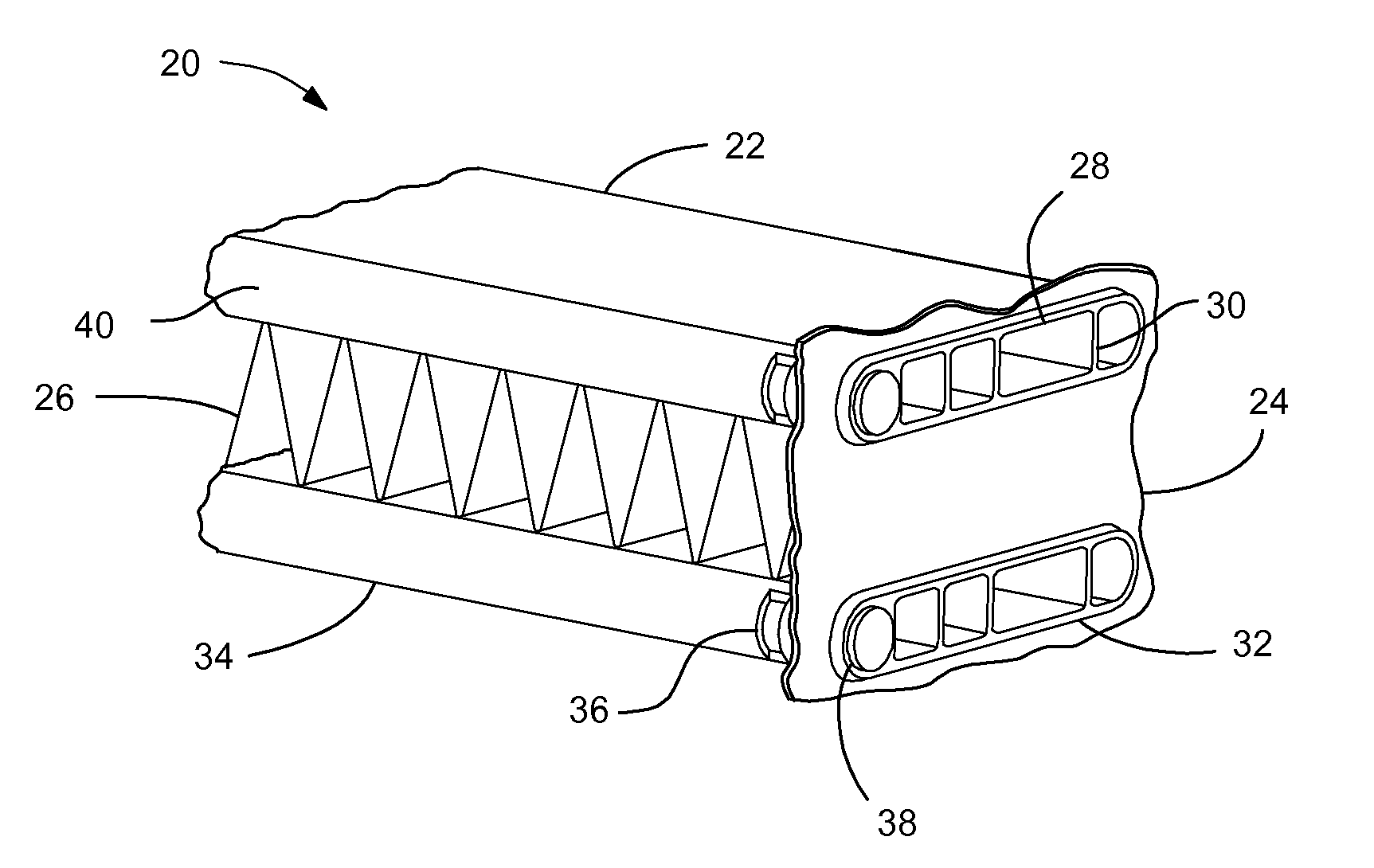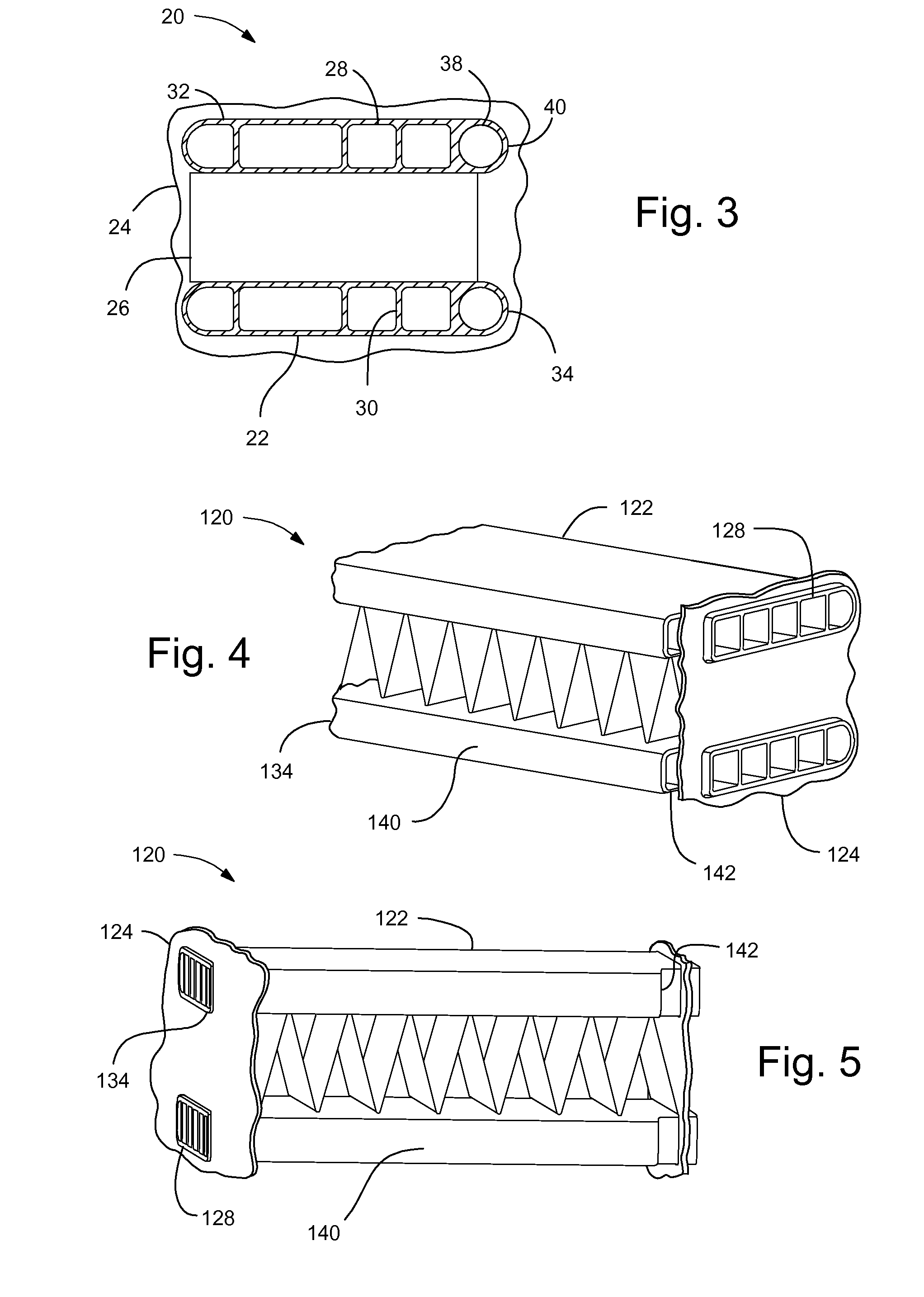Vehicle heat exchangers having shielding channels
a technology of heat exchanger and shielding channel, which is applied in the direction of indirect heat exchanger, heat exchange apparatus safety devices, lighting and heating apparatus, etc., can solve the problems of affecting the resistance of the heat exchanger, the fluid flowing through the broken tube can be leaking more than is desirable, and the cost of implementing the protection screen can be more than desirable, so as to reduce the cost and weight, the effect of improving the resistance to leakage and cost-effectiveness
- Summary
- Abstract
- Description
- Claims
- Application Information
AI Technical Summary
Benefits of technology
Problems solved by technology
Method used
Image
Examples
first embodiment
[0015]Both tubes 22 shown in the first embodiment are shielded tubes—that is, the tubes 22 both also include a shielding channel 34 extending across the front 40 of the heat exchanger 20 between the headers 24. The front 40 of the heat exchanger 20 is the side of the heat exchanger 20 that will face toward the front of the vehicle in which it will be used. The shielding channels 34 are, of course, located along the front of the tubes 22 because this is the most likely location for a significant impact from an object, such as a stone, while operating the vehicle.
[0016]Each end of each shielding channel 34 includes a plug 38. The plugs 38 seal the ends to prevent fluid in the headers 24 from entering the shielding channels and leaking out of the heat exchanger 20. The plugs 38 may by made of wire with cladding on it so that the plugs 38 will be welded to the ends of the shielding channels 34 during a brazing process the heat exchanger 20 undergoes during assembly. Of course, other typ...
second embodiment
[0021]FIGS. 4-5 illustrate the shielded heat exchanger 120. Since this embodiment is similar to the first, similar element numbers will be used for similar elements, but employing 100-series numbers.
[0022]In this embodiment, the shielding channels 134 at the front 140 of each tube 122 extend almost all of the way across between the headers 124, but stop just short, at open channel ends 142. Thus, while the flowing channels 128 still extend to and direct fluid between the headers 124, the shielding channels 134 do not contact or extend into the headers 124. With this configuration, no brazing or other means of sealing needs to take place to assure that fluids do not leak from the headers 124 into the shielding channels 134.
[0023]In addition, the cross sectional shape of the shielding channels 134 can be whatever is desirable to provide the most advantageous combination of ability to absorb impact energy while minimizing manufacturing costs. This flexibility in cross sectional shape i...
third embodiment
[0024]FIGS. 6-7 illustrate the shielded heat exchanger 220. Since this embodiment is similar to the first, similar element numbers will be used for similar elements, but employing 200-series numbers.
[0025]In this embodiment, one of the tubes is a shielded tube 222 while the other tube is a non-shielded tube 244, with of course a row of fins 226 between them. Thus, there may be a zone 246 of shielded tubes 222 and a zone 248 of non-shielded tubes 244. This illustrates that not all of the tubes need to be shielded tubes. It may be preferable for a particular vehicle application to have only a few of the lowest tubes on the heat exchanger be shielded to provide protection from projectiles while the upper tubes are non-shielded to save weight and cost. Of course, this is applicable to the other embodiments as well.
[0026]For the shielded tube 222, the flowing channels 228 are open to the headers 224 while the shielding channel 234 has welded ends 238 that block fluid flow into this chann...
PUM
| Property | Measurement | Unit |
|---|---|---|
| air pressure drop | aaaaa | aaaaa |
| thickness | aaaaa | aaaaa |
| energy | aaaaa | aaaaa |
Abstract
Description
Claims
Application Information
 Login to View More
Login to View More - R&D
- Intellectual Property
- Life Sciences
- Materials
- Tech Scout
- Unparalleled Data Quality
- Higher Quality Content
- 60% Fewer Hallucinations
Browse by: Latest US Patents, China's latest patents, Technical Efficacy Thesaurus, Application Domain, Technology Topic, Popular Technical Reports.
© 2025 PatSnap. All rights reserved.Legal|Privacy policy|Modern Slavery Act Transparency Statement|Sitemap|About US| Contact US: help@patsnap.com



